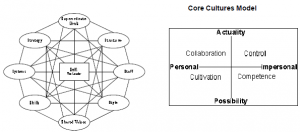Alan P. Hyatt and Drs. Michael P. Thompson, Organizational Leadership and Strategy; Ernest J. Nielsen, Office of Information Technology
My study provided the research for my honors thesis. The thesis discusses and develops the Theory of Conscious Alignment (TCA). The theory states that leaders and managers who consciously mold the strategy and culture of their organizations, and align the two intangible elements, will be much more effective. By aligning these two critical elements, the ongoing project work of the organization will also be aligned with them both, and the espoused strategic objectives and initiatives will be accomplished.
Based on both primary and secondary research, the thesis examines several important connections between strategy, core business culture, and the project work of the organization. First, I explore the relationship of strategy and culture, defining the two terms and identifying their components. Second, I discuss the importance of culture as a guiding factor behind the actual work that is accomplished in the organization. Third, I set forth the role of the leader in forming the culture, postulating that it should be a conscious effort by the leader. Fourth, I identify how the alignment or misalignment of strategy and culture affects the project work of the organization.
Analysis Tools
To frame the primary research questions and analysis, I used the two models shown below, Jack Weber’s Expanded 7-S Model, (1998) University of Virginia, and William Schneider’s Core Cultures Model (1994).
Research
My primary research included a case study and a survey. I inquired, interviewed, surveyed and gathered data about three large Information Technology (IT) departments that had experienced a transition in leadership within the last 18 months. The three IT are departments within a large university, a large, global non-profit service firm, and a government organization respectively. I conducted interviews with the current Chief Information Officer (CIO) in each organization, and the former CIO in two of the three organizations, as well as members of each CIO’s current or former staff. In addition, I surveyed 100 employees in each IT organization, using Schneider’s method to model the culture of each organization based on the responses.
In the interviews, I asked questions about each “S”-element from the Expanded 7-S Model, then asked broader questions about the alignment of the several elements. For each question, I requested a three part answer: (1) about the conditions in the organization just prior to the his/her appointment to the position, (2) the current condition of the organization at the time of the interview, and (3) his/her vision of the optimal strategy and culture situation in the future.
Conclusions
The research confirmed the basic premise of the null hypothesis—the importance of consciously aligning the elements of strategy and core business culture. I also contend that effective leadership includes not only the effort to achieve alignment, but also clear, frequent communication of those designs to the entire orga nization.
The Theory of Conscious Alignment model outlines the process of connecting the actual work of the organization to the espoused strategy and the underlying culture. The discussion of the relationship of culture to strategy formulation and strategy implementation is an important addition to the TCA. The thesis underscores the essential role of the leader in aligning those elements— simply put, most leaders will spend more time implementing their strategy than formulating it. They must consciously align the strategy and culture in order to translate sound strategy formulation into superb strategy implementation.
Both the implementation and the formulation must be communicated directly to the organization by the leader throughout the process in order for the implementation to be successful. In short, the leader must consistently provide both strategic and cultural leadership.
In addition to the insights gleaned from this initial research, several interesting questions shown below arise from the findings that remain to be answered by further research. I am very grateful to my advisors, and to my research partner, Justin Allen, for their insights, suggestions, and diligent work and support during the project. I am also grateful to the Office of Research and Creative Activities for facilitating the research through a generous scholarship.


